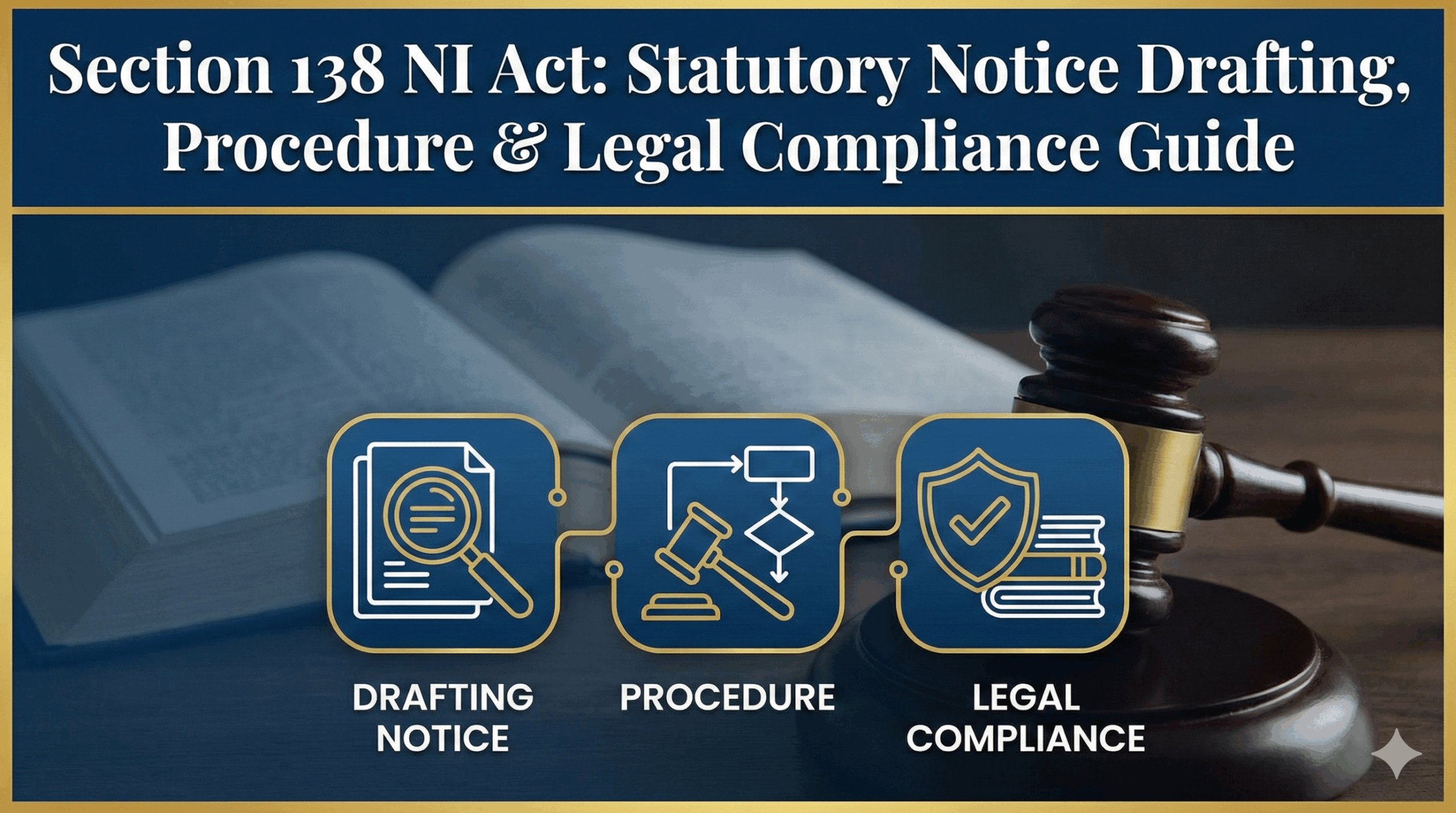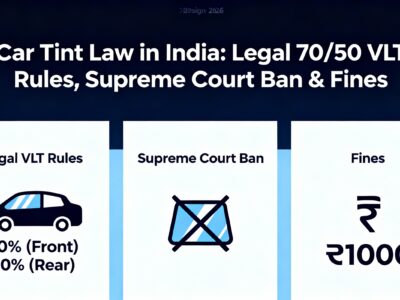Is your landlord illegally withholding your security deposit? It’s a common problem, but you have clear legal rights. This complete guide for tenants across India breaks down every step to get your money back. We’ll cover the power of your rental agreement, what deductions are actually legal, how to use our interactive decision tree to choose your legal path, and provide a legal notice template to show you’re serious. Stop feeling helpless and start taking informed action to recover what’s rightfully yours.
TENANT RIGHTS IN INDIA
The Tenant's Shield: Your Complete Guide to Recovering a Security Deposit
Landlord wrongfully withholding your deposit? Understand your legal rights, what constitutes a valid deduction, and the step-by-step process to get your money back across India.
The Foundation: Your Rental Agreement
Your tenancy is a legal contract. Understanding its components is the first step in protecting your rights and your security deposit.
The Power of a Written Agreement
A rental agreement is more than a formality; it's a legally binding contract under the Indian Contract Act, 1872. It outlines the rights and duties of both you and your landlord. A clear, comprehensive, and legally valid agreement is your primary shield against disputes.
Must-Have Clauses
- Security Deposit: Amount, purpose, and refund timeline.
- Maintenance: Who pays for what (major vs. minor repairs).
- Termination: Notice period and lock-in details.
- Fittings List: An inventory of items provided.
Legal Formalities are Crucial
- Stamp Duty: Must be on a stamp paper of appropriate value.
- Registration: Mandatory for leases longer than 11 months.
- An unregistered long-term lease is not valid evidence in court.
How Much Deposit is Legal?
The maximum deposit a landlord can ask for depends on where you live. The Model Tenancy Act (MTA), 2021 has changed the rules, but only in states that have adopted it.
Is your state governed by the Model Tenancy Act (MTA)?
What Can a Landlord Legally Deduct?
This is the heart of most disputes. A landlord can't just keep your money for any reason. The law distinguishes between actual damages and the natural aging of a property.
Normal Wear & Tear vs. Actual Damage
Normal Wear & Tear
This is the expected, gradual decline from normal use. The landlord must pay for this.
- ✔ Faded paint or minor scuffs on walls.
- ✔ Worn-out carpet in high-traffic areas.
- ✔ Minor scratches on floors or countertops.
- ✔ Sticky cabinet doors or loose grout.
Damage
This is harm caused by negligence, misuse, or accidents. This can be deducted from your deposit.
- ✖ Large holes in walls or crayon drawings.
- ✖ Large stains, burns, or broken tiles on floor.
- ✖ Broken appliances, windows, or cabinet doors.
- ✖ Clogged drains due to improper disposal.
The Landlord's Burden of Proof
A landlord cannot just name a price. They MUST provide an itemized list of damages with original bills or invoices for the repairs. Without proof, their claim is legally weak.
How to Get Your Money Back: A Step-by-Step Plan
If your landlord refuses to cooperate, the law provides a clear path forward. Follow these steps strategically to build a strong case.
Formal Communication
Send a polite but firm email or letter requesting the refund. State the facts, reference your agreement, and give a deadline (e.g., 15 days). This creates a paper trail.
Send a Legal Notice
If there's no response, hire a lawyer to send a formal legal notice. This shows you're serious and often results in a settlement without going to court.
File a Complaint
If all else fails, file a case. You have several options, each with pros and cons. Choose your battlefield wisely.
Choosing Your Battlefield: Where to File a Case
| Parameter | Rent Authority (MTA States) | Consumer Court | Civil Court |
|---|---|---|---|
| Speed | Fastest (Goal: 60 days) | Fast | Slowest (Years) |
| Cost | Low | Very Low (Nominal fees) | High (Court & lawyer fees) |
| Procedure | Simple, quasi-judicial | Simple, consumer-friendly | Complex, formal, requires lawyer |
| Relief | Refund + Penalties | Refund + Compensation for Harassment | Refund + Interest + Legal Costs |
| Best For | Tenants in MTA states (UP, TN, etc.). The ideal option. | Most tenants in non-MTA states. Good balance of speed, cost, and relief. | Complex cases with large sums, as a last resort. |
Your Legal Action Decision Tree
Feeling lost? Follow this visual guide to navigate the steps for recovering your security deposit. Start at the top and follow the path that matches your situation.
START: Landlord withholds deposit after you vacate.
First action: Send a formal written request (email/letter) for refund with a deadline.
Did the landlord refund the deposit?
Congratulations!
Your issue is resolved.
ACTION: Hire a lawyer to send a formal Legal Notice.
Did the landlord refund after the Legal Notice?
Congratulations!
The legal notice worked.
ACTION: Time to file a case.
First, check your state's law.
Is your state under the Model Tenancy Act (MTA)?
File with the Rent Authority.
This is the fastest and best option.
Choose your forum:
Consumer Court: Faster, cheaper, can get compensation.
Civil Court: Slower, expensive, for complex cases.
Deep Dive: Procedures, Precedents & Case Studies
Understanding the 'how' and 'why' of the legal process can empower you to build a winning case. Here's what happens after you decide to file a complaint.
Procedural Guide: Filing Your Complaint
- Draft Application: Create a formal application detailing the parties, facts, grievance, and relief sought.
- Attach Evidence: Compile all documents: rental agreement, payment proofs, legal notice, photos, etc.
- File & Scrutinize: File the application at the district Rent Authority's office for review.
- Notice to Landlord: The Authority issues a notice to the landlord to appear and reply.
- Hearing & Order: The Authority hears both sides and aims to pass an order within 60 days.
- Register Online: Create an account on the national e-Daakhil portal.
- Select Jurisdiction: Choose the correct District, State, or National commission based on your claim value.
- Fill Complaint Form: Detail the facts, arguing wrongful retention of deposit as a "deficiency in service."
- Upload Documents: Scan and upload all your evidence and a notarized affidavit.
- Pay Fee & Submit: Pay the nominal fee online and submit. You will get a reference number to track your case.
- Hire a Lawyer: This process is complex and requires legal assistance to draft a "plaint."
- Pay Court Fees: Fees are a percentage of the claimed amount (ad valorem) and can be significant.
- Filing & Summons: The plaint is filed, and the court issues a summons to the landlord.
- Lengthy Trial: The process involves a written statement from the landlord, evidence presentation, cross-examinations, and final arguments.
- Judgment & Decree: If you win, the court issues a decree. You may need to file a separate "execution petition" to enforce payment if the landlord still refuses to pay.
Learning from the Courts: Key Precedents
The Landlord's Burden of Proof is Absolute
A core principle upheld by courts across India is that the responsibility to prove that deductions are for legitimate damages lies entirely with the landlord. A landlord cannot make vague claims or deduct arbitrary amounts. They must provide concrete evidence like an itemized list of damages, photos, and original repair bills. Without this proof, their claim is legally weak and likely to be dismissed.
Deposit Refund is Contingent on Tenant's Duties
The Supreme Court has clarified that a security deposit refund is not an unconditional right. A tenant who has breached their own core duties (like not paying rent or refusing to vacate after the lease ends) cannot claim the full deposit as a "legally enforceable debt." The landlord's duty to refund is tied to the tenant's duty to hand over peaceful and vacant possession of the property.
Case Study in Focus: The Bengaluru Tenant's Ordeal
The Scenario: A tenant in Bengaluru paid a ₹1.5 lakh deposit. Upon vacating, the landlord deducted ₹82,000, providing only a vague, handwritten note as justification. Charges included ₹55,000 for "repainting" and ₹25,000 for "miscellaneous damages."
The Legal Analysis: This is a classic example of wrongful deduction.
- No Proof: The landlord failed the burden of proof by not providing any bills or evidence.
- Normal Wear & Tear: Repainting after a two-year tenancy is typically considered maintenance for normal wear and tear, which is the landlord's cost.
- Vague Claims: "Miscellaneous damages" is legally meaningless without an itemized list.
This case highlights the importance of demanding itemized bills for every single deduction. Without proof, a landlord's claims are just that—claims.
Legal Notice Format Template
This template provides the basic structure for a legal notice. It should be sent by a qualified advocate on their official letterhead. Use this as a guide to understand the necessary components.
Legal Notice for Recovery of Security Deposit
**From the Offices of [Advocate's Name/Law Firm]** [Advocate's Full Address] [Advocate's Contact No. & Email] ------------------------------------------------------------------ Ref. No: [Reference Number] Date: [Date of Notice] **BY REGISTERED POST WITH ACKNOWLEDGEMENT DUE (RPAD)** To, [Landlord's Full Name] [Landlord's Full Address] **Subject: Legal Notice for the recovery of security deposit amounting to Rs. [Amount]/- concerning the property at [Full Property Address].** Sir/Madam, Under the instructions and on behalf of my client, [Your Full Name], son/daughter of [Your Father's Name], currently residing at [Your Current Full Address] (hereinafter referred to as "my Client"), I do hereby serve you with the following legal notice: 1. That my Client entered into a rental agreement with you dated [Date of Agreement] for a period of [Duration, e.g., 11 months] for the premises located at [Full Property Address] (hereinafter "the said premises") at a monthly rent of Rs. [Monthly Rent Amount]/-. 2. That at the time of entering into the said agreement, my Client paid you a sum of Rs. [Amount]/- (Rupees [Amount in words]) as a refundable interest-free security deposit, the receipt of which is duly acknowledged in the said rental agreement. 3. That my Client has duly complied with all the terms of the rental agreement, including the timely payment of rent and other charges, and has maintained the said premises in good condition. 4. That my Client vacated the said premises on [Date of Vacating] after providing the contractually stipulated notice period and handed over the peaceful and vacant possession to you on the same day. 5. That as per Clause [Clause Number] of the said rental agreement, you are legally bound to refund the security deposit of Rs. [Amount]/- to my Client at the time of receiving vacant possession of the said premises. 6. That despite my Client's repeated oral requests and reminders, you have failed and/or neglected to refund the said security deposit amount, without any valid reason or justification. Your act of wrongfully withholding the security deposit constitutes a breach of the rental agreement and is illegal. I, therefore, through this legal notice, call upon you to pay my Client the sum of Rs. [Amount]/- (Rupees [Amount in words]) within a period of 15 (fifteen) days from the date of receipt of this notice. Should you fail to comply with this notice, my Client shall be constrained to initiate appropriate legal proceedings against you in a competent court of law, be it the Rent Authority, Consumer Court, or Civil Court, for the recovery of the aforesaid amount along with interest, damages, and costs, for which you shall be held entirely responsible. A copy of this notice is retained in my office for further necessary action. Yours faithfully, (Signature) **[Advocate's Name]** Advocate
Your Proactive Tenant Checklist
Prevention is the best cure. Follow these best practices from day one to protect yourself from future disputes.
Before You Sign the Lease
- 1.Insist on a Written Agreement: Never accept a verbal agreement.
- 2.Verify Legalities: Ensure it's properly stamped and registered if over 11 months.
- 3.Scrutinize Clauses: Read the deposit, maintenance, and termination clauses carefully.
During Your Tenancy
- 1.Document Everything: Create a joint move-in inspection report with timestamped photos/videos of any pre-existing damage.
- 2.Communicate in Writing: Use email or WhatsApp for all important conversations with the landlord.
- 3.Keep Payment Records: Save all rent receipts and proof of deposit payment. Use bank transfers for an automatic trail.









